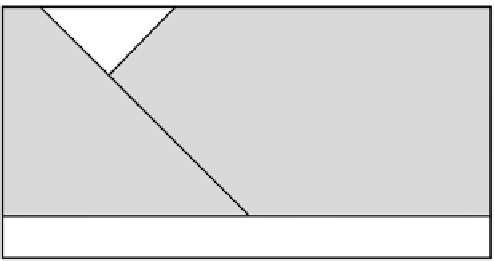Geoscience Reference
In-Depth Information
30. The deep survey of Problem 28 wasrun over the cross section shown in Fig. 4.58.
Velocities and densities are given below.
Sedimentary
rocks
Basement 1
Basement 2
Velocity (km s
−1
)
3.0
6.0
6.0
Density (10
3
kg m
−3
)
2.2
2.6
2.7
(a) By considering rays perpendicular to the reflectors, draw the corresponding time
section. Use a scale of 2 cm
=
5kmand1cm
=
1s. Ignore diffractions.
(b) Draw a rough sketch of the shape of the Moho which would be obtained after
migration if this section had mistakenly been migrated at a constant velocity of
6kms
−
1
. Ignore diffractions.
31. What is the reflection coefficient of the fault shown in Fig. 4.58, (a) at the sediment-
basement contact and (b) within the basement?
32. Desperate to find something of interest in the data of Problems 29 and 30,J.R.Ewing
authorized heat-flow measurements over the sedimentary basin of Fig. 4.58.Ifthe
surface heat flow is 0.75 mW m
−
2
and the thermal conductivity is 2.5 W m
−
1
◦
C
−
1
,
what is the temperature (a) at the base of the sediments and (b) at the Moho? State
your assumptions and comment on your answer (see Chapter 7). (Problems 28-32 are
from Cambridge Natural Science Tripos II, 1986.)
Figure 4.58.
The vertical
cross section for
Problems 30 and 31.
Distance (km)
0
20
40
60
0
45
o
Sediments
10
Basement 1
20
Basement 2
45
o
30
Moho
33. Your foot is trapped under a railway sleeper. You feel the rail vibrate and then 20 s
later hear a faint whistle. Estimate how much time you have to free yourself. State
your assumptions.
References and bibliography
Abercrombie, R. and Leary, P. 1993. Source parameters of small earthquakes recorded at
2.5 km depth, Cajun Pass, Southern California: implications for earthquake scaling.
Geophys. Res. Lett.
,
20
, 1511-14.






